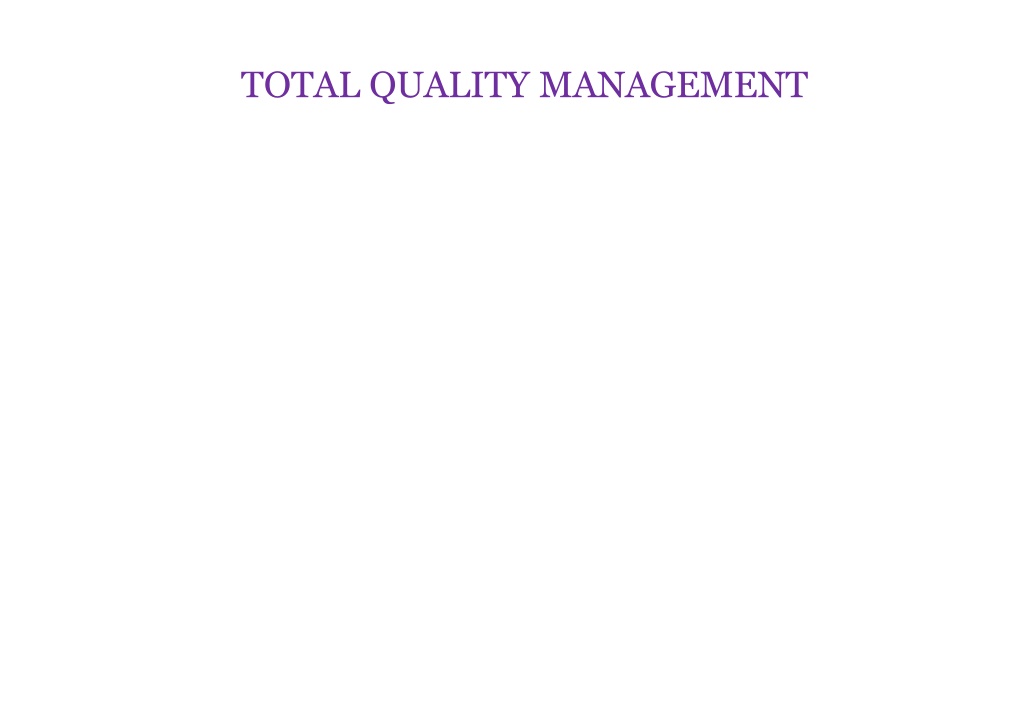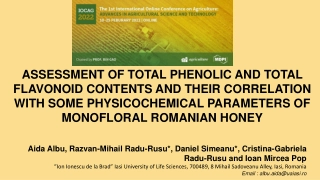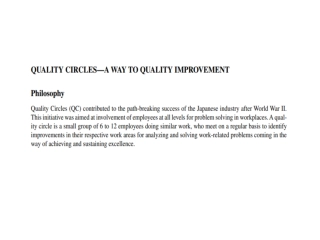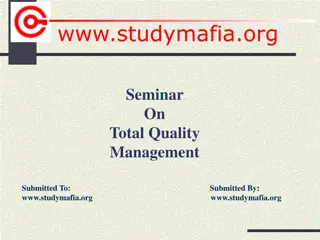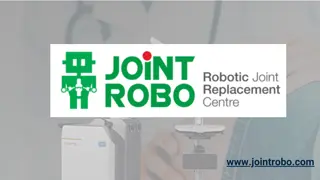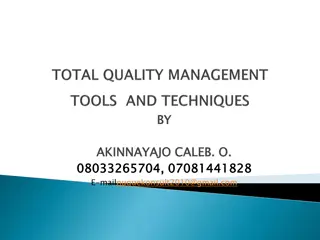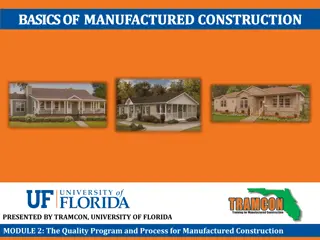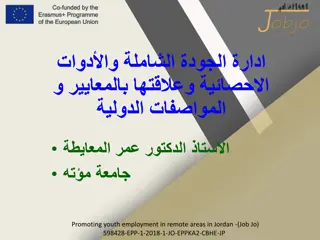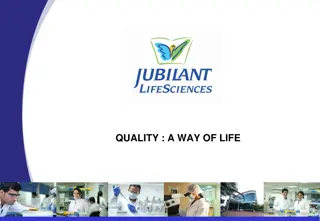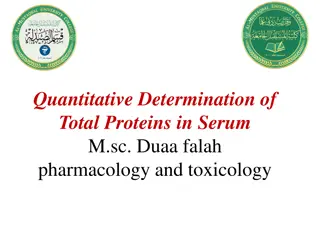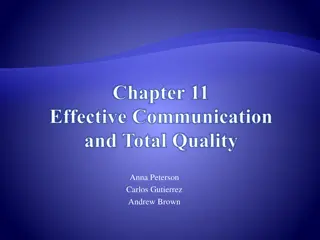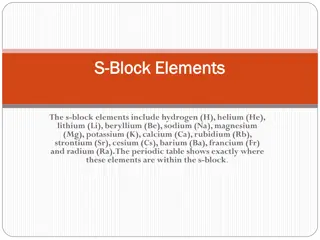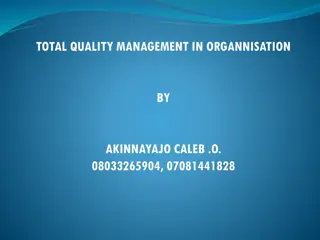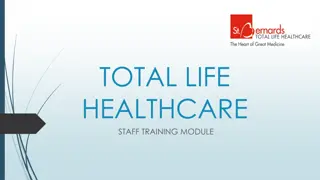Understanding Total Quality Management (TQM) and Its Key Elements
Total Quality Management (TQM) is an organizational approach focused on achieving excellence by managing the entire process to ensure quality at every level. It emphasizes customer satisfaction, continuous improvement, teamwork, and process efficiency. TQM involves key elements such as committed management, customer relations, benchmarking, employee empowerment, and process improvements. By adopting TQM principles, organizations aim to prevent errors, enhance quality, and achieve long-term success through customer satisfaction.
Download Presentation

Please find below an Image/Link to download the presentation.
The content on the website is provided AS IS for your information and personal use only. It may not be sold, licensed, or shared on other websites without obtaining consent from the author. Download presentation by click this link. If you encounter any issues during the download, it is possible that the publisher has removed the file from their server.
E N D
Presentation Transcript
Contents Introduction. Concepts of tqm. Benefits of tqm. Characteristics of tqm. Key elements of tqm. Tqm in pharma industry. Advantages. Disadvantages. Conclusion. References. TOTAL QUALITY MANAGEMENT 2
Introduction Total - made up of the whole Quality - degree of excellence a product or service provides Management - act, art or manner of planning, controlling, directing, . Therefore, TQM is the art of managing the whole to achieve excellence. TOTAL QUALITY MANAGEMENT 3
The concept of TQM Produce quality work the first time. Focus on the customer. Have a strategic approach to improvement. Improve continuously. Encourage mutual respect and teamwork. TOTAL QUALITY MANAGEMENT 4
Various Definitions Total quality management (TQM) has been defined as an integrated organizational effort designed to improve quality at every level. The process to produce a perfect product by a series of measures require an organized effort by the entire company to prevent or eliminate errors at every stage in production is called total quality management. According to international organization for standards defined tqm as, TQM is a management approach for an organization, centered on quality, based on the participation of all its members and aiming at long-term success through customer satisfaction and benefits to all members of the organization and to thesociety. TOTAL QUALITY MANAGEMENT 5
Characteristics of TQM Committedmanagement. Adopting management. Closer customer relations. Closer provider relations. Benchmarking. Increased training. Open organization Employee empowerment. Flexible production. Process improvements. Process measuring and communicating about total quality TOTAL QUALITY MANAGEMENT 6
Traditional approach and TQM Quality element Definition Previous state Product-oriented TQM Customer-oriented Priorities Second to serviceand cost First among equalsof service and cost Short-term Detection Operations Quality Control Managers Long-term Prevention System Everyone Teams Delegate,coach, facilitate, and mentor Decisions Emphasis Errors Responsibility Problem solving Manager s role Plan, assign, control, and enforce TOTAL QUALITY MANAGEMENT 7
The three aspects of TQM Counting Tools, techniques, and training in their use for understanding, and solving quality problems Quality for the customer as a driving force and central concern. analyzing, Customers Culture Shared expressed by leaders, that define and support quality. values and beliefs, TOTAL QUALITY MANAGEMENT 8
Principles of tqm 1. Produce quality work the first time and everytime. 2. Focus on the customer. 3. Have a strategic approach to improvement. 4. Improve continuously. 5. Encourage mutual respect and teamwork TOTAL QUALITY MANAGEMENT 9
The key elements of the TQM Focus on the customer. Employee involvement Continuousimprovement TOTAL QUALITY MANAGEMENT 10
Focus on the customer It is important to identify the organization scustomers. External customers consume the organization s product or service. Internal customers are employees who receive the output of other employees. TOTAL QUALITY MANAGEMENT 11
Employee Involvement Since the quality is considered the job of all employees, employees should be involved in quality initiatives. Front line employees are likely to have the closest contact with external customers and thus can make the most valuable contribution to quality. Therefore, employees must have the authority to innovate and improve quality. TOTAL QUALITY MANAGEMENT 12
Continuous improvement TOTAL QUALITY MANAGEMENT 13
Continuousimprovement TOTAL QUALITY MANAGEMENT 14
CONTINUOUS IMPROVEMENT The quest for quality is a never-ending process in which people are continuously working to improve the performance, speed and number of features of the product or service. Continuous improvement means improvement that occurs on a regular basis will eventually add up to vast improvement in quality. TQM is the management process used to make continuous improvements to all functions. TQM represents an ongoing, improvement. The foundation of total quality is a management philosophy that supports meeting customer requirements through continuous improvement. that small, incremental continuous commitment to TOTAL QUALITY MANAGEMENT 15
Continuous Process Improvement. View all work as process production and business. Process purchasing, design, invoicing, etc. Inputs process outputs. Process improvement increased customersatisfaction. Improvement 5 ways: reduce resources, reduce errors, meet expectations of downstream customers, make process safer, make process more satisfying to the person doing TOTAL QUALITY MANAGEMENT 16
THE TQM SYSTEM Continuous Improvement Objective Principles Custom er Focus Leadership Education and Training structure Communications recognition Measurement Process Improvem ent Total Involvem ent Supportive Elements Reward and TOTAL QUALITY MANAGEMENT 17
BENEFITS OF TQM: Improved quality. Employee participation. Team work. Working relationships. Customersatisfaction. Employee satisfaction. Productivity. Communication. Profitability. Market share. TOTAL QUALITY MANAGEMENT 18
Importance of TQM in pharma industry Handling: Containers should be opened carefully and subsequently resealed in an approved manner. Highly sensitising material cephalosporins should be handled in separate production areas. Highly active or toxic API (e.g. certain steroids, cytostatic substances) should be manufactured in a dedicated area and using dedicated equipment. Pure and final API should be handled in an environment giving adequate protection against contamination. such as penicillins and TOTAL QUALITY MANAGEMENT 20
Storage: Secure storage facilities should be designated for use to prevent damage or deterioration of materials. These should be kept clean and tidy and subject to appropriate pest control measures. Environmental conditions should be recorded. The condition of stored material should be assessed at appropriate intervals. Storage conditions for api should be based upon stability studies taking into account time, temperature, humidity, lightetc TOTAL QUALITY MANAGEMENT 21
Packaging: Labelling and packaging processes should be defined and controlled to ensure that correct packaging materials are used correctly and other specified requirements are met. Printed labels should be securely stored to avoid mix-ups arising. Marking and labelling should be legible and durable, provide sufficient information, for indicate, if appropriate, required storage conditions, retest and/or expiry date. accurate identification and TOTAL QUALITY MANAGEMENT 22
Facilities and equipment: The location, design, and construction of buildings should be suitable for the type and stage of manufacture involved, protecting the product from contamination (including cross-contamination) and protecting operators and the environment from the product. Equipment surfaces in contact with materials used inapi manufacture should be non-reactive. TOTAL QUALITY MANAGEMENT 23
Sterile area Personnel suffering from an infectious disease or having open lesions on the exposed surface of the body should avoid activities which could compromise the quality of API. Smoking, eating, drinking, chewing and storage of food should be restricted to designated areas separated from production or control areas. TOTAL QUALITY MANAGEMENT 24
Labelling Each container should be identified by an appropriate label, showing at least the product identification and the assigned batch code, or any other easily understandable combination of both. . Containers additional labels. for external distribution may require TOTAL QUALITY MANAGEMENT 25
Computerised systems . Computer systems should be designed and operated to prevent unauthorised entries programme. or changes to the In the case of manual entry of quality critical data there should be a second independent check to verify accuracy of the initial entry. A back-up system should be provided of all quality critical data. TOTAL QUALITY MANAGEMENT 26
Advantages of tqm Improves reputation- faults and problems are spotted and sorted quicker. Higher employee morale- workers motivated by extra responsibility ,team work and involvement indecisions of tqm. Lower cost. Decrease waste as fewer defective products and no need for separate. TOTAL QUALITY MANAGEMENT 27
Disadvantages of tqm Initial introductioncost. Benefits may not be seen for severalyears. Workers may be resistant to change. TOTAL QUALITY MANAGEMENT 28
A model for organizationmanagement. TOTAL QUALITY MANAGEMENT 29
Models of tqm TOTAL QUALITY MANAGEMENT 30
BENEFITS OF TOTAL QUALITY MANAGEMENT Financial benefits include lower costs, higher returns on sales and investment, and the ability to charge higher rather than competitive prices. Improved access to global markets, higher customer retention levels, less Time required to develop new innovations, and a reputation as a quality firm. Total quality management (tqm) is one such approach that seeks to improve quality and Performance which will meet or exceed customer expectations. TOTAL QUALITY MANAGEMENT 31
CONCLUSION: TQM organization as whole. Using Quality management reduces rework nearly to zero in an achievable goal .The responsibilities either its professional, social, legal one that rest with the pharmaceutical manufacturer for the assurance of quality of product are tremendous and it can only be achieved by well organised. Work culture and complete engagement of the employees at the work place. It should be realised that national & international regulations must be implemented systematically and process. Control should be practiced rigorously. Thus quality is critically important ingredient to organisational success today which can be achieved by TQM, an organisational approach that focusses on quality as an over achieving goals, aimed at aimed at the prevention of defects rather than detection of defects.. encourages participation amongst employees, managers and TOTAL QUALITY MANAGEMENT 32
Reference: Text book of Total Quality Management by L.Suganthi and Anand A.Samuel,2nd edition,2005,pageno.49-61. Total Quality Management by R.S Nagarajan, A.A.Arivalangar,new age international publishers,1st edition,2009,page no.21. www.slideshare.com/tqm in pharma industry. TOTAL QUALITY MANAGEMENT 33
